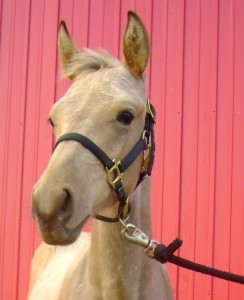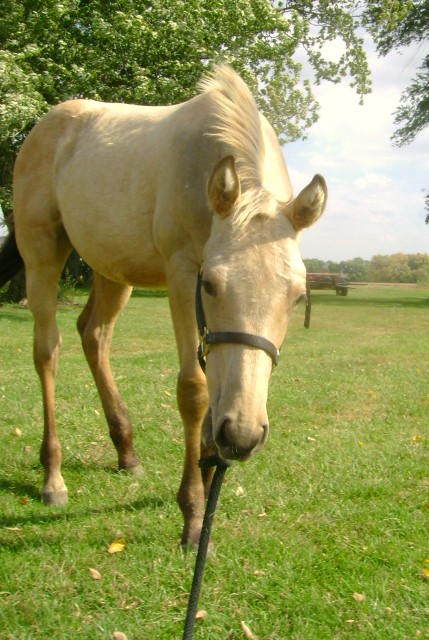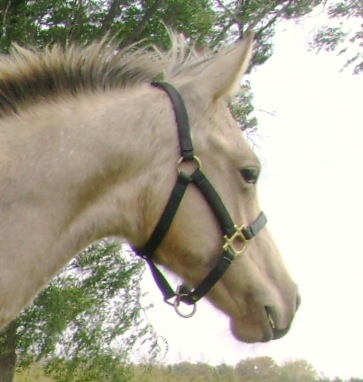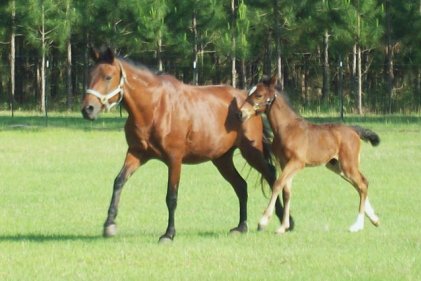 As you know, we have been working on halter breaking the new stud colt we purchased a month ago. It’s been awhile since I’ve had a horse this young to work with, so I’m trying to remember any tricks on how to train a foal to lead, and am looking back through some old horse training articles I’ve written to see what advice I’ve given to others on this topic. Every horse is different, and with this particular colt, we’ve been able to slide right past some trouble spots that might affect others. For instance, he is easy to catch and halter—in fact, he will come up to you wanting handled! He is also naturally obliged to give to pressure, so after just having the halter on twice, he follows us around happily. But every horse is not this willing, and there are some tips and suggestions I’d like to share for training your young horse to lead.
As you know, we have been working on halter breaking the new stud colt we purchased a month ago. It’s been awhile since I’ve had a horse this young to work with, so I’m trying to remember any tricks on how to train a foal to lead, and am looking back through some old horse training articles I’ve written to see what advice I’ve given to others on this topic. Every horse is different, and with this particular colt, we’ve been able to slide right past some trouble spots that might affect others. For instance, he is easy to catch and halter—in fact, he will come up to you wanting handled! He is also naturally obliged to give to pressure, so after just having the halter on twice, he follows us around happily. But every horse is not this willing, and there are some tips and suggestions I’d like to share for training your young horse to lead.
A few thoughts beforehand: It is easier to train a small horse than a large one….so don’t put it off! One of the biggest misconceptions about owning a foal is thinking that there’s just not that much you can do with it until it’s full-grown. The best time for starting a horse in training is when it’s a few minutes old, and if you missed out on that, then you’re running late. I would like to point out that any time you are around the foal, you are training it, whether you realize it or not. A foal is naturally curious, and will always be forming it’s own opinions and concepts based on what its senses reveal to it. So if you’re in the pen cleaning out its watering tank, the foal is learning from you. If you’re tossing hay into the foal’s feeder, it is learning from you. So always be aware of your actions around a foal, and try not to put out negative energy or frightening body language, as that will put a mental note in the foal’s memory to avoid you at all costs.
That being said, there are situations you can provide to help your foal learn more from his surroundings. Our foal dislikes the hay being tossed over the fence into his feeder, and moves away every time. But I have continued to toss it, rather than try to slide it into the feeder carefully, with the goal of him learning to get used to it (his mother stands there placidly eating, helping to reinforce that there’s nothing to be afraid of), and he is becoming calmer and more accepting of moving hay piles. Also, we have a lot of farm equipment and noisy traffic past their corral, and I always think this prepares them for riding along busy roads later on. You can also tie a piece of plastic bag to the fence so the wind catches it, or place a tarp in an area the foal must pass through, and this will also tune their senses to not be afraid of silly things like that.
To introduce the halter, you may have to work at getting the foal to let you near it. If your foal is particularly spooky, I would suggest putting him in a stall, horse trailer, or smaller enclosure to reduce his ability to get away from you. A young horse’s fear can be overcome simply by spending a lot of time around it, so if you have time at your disposal, just sitting in the horse’s pen near his feed source will help him get used to you and not be afraid. But if you don’t have all day every day to work with him, just put him in a stall, it will save time.
Work with the foal using a technique similar to the join up horse training method where you attempt to get close to the foal (reach out a friendly hand towards his shoulder) and if he scoots away from you, advance after him (watch his heels!), trying to maintain a position parallel to his shoulder as he moves around the stall. Reaching for his face will scare him, reaching for his hind end will get you kicked. So put your hand towards his shoulder, and when he allows you to pet him there, he will start to relax. If you get him to let you touch his shoulder, then retreat and say “good boy” in a calming, sweet voice. He will almost always turn to look at you, then, indicating he is thinking of being near you, and indicating his relief and acceptance that you didn’t hurt him any. So then try to touch him again on the shoulder. If he lets you, just start petting him softly and talking to him. If he circles the stall, try to keep alongside his shoulder (if he swings his hind end towards you, step back quickly to stay clear in case he kicks, but speak in a harsher voice to him and wave your arms at him to indicate this was the wrong behavior) and then try get close to him again. Whenever he lets you touch him, use your body language and softer voice to show him that this was the right behavior, and allow him to rest and relax as you pet him, then step back to take off any pressure or anxiety and reinforce that he is doing the right thing by letting you pet him.
When the foal allows you to touch it, then you simply work on touching it more. Work from the shoulder up the neck, and at this point you can also introduce the lead rope. Chances are, the colt will accept you only on one side, so work on his “best side”, and don’t worry about getting him to let you touch him on the other side until you have him haltered and are able to control him a little more. You want to keep your movements slow and low key as long as he is accepting you (turning his heels or hind end towards you is a threat, and should be taken as such—I never accept this from any horse, and even if you scare him a little, it’s worth it to show him that threatening to kick is not okay—I suggest that if he turns his heels, you maintain a safe distance but raise your voice, wave your arms, toss a lead rope at his hind end, anything to get the result of him turning back to face you). Then become all sweetness and light again. This is how you reward the colt for the right thing, you use body language and voice tone to teach him right and wrong.
When you can get a lead rope around the colt’s neck, you are really making progress. Don’t push the issue though. For instance, if the feel of the rope spooks him, you can always let it fall off and start back at square one, which is getting close and petting his shoulder and neck again. The foal should learn to like the petting, and learn to relax with you. Then you just repeat and work on getting past where you got the last time. So rub with the lead rope, then get it looped over his neck, and then pet him more so he stays relaxed, then introduce the halter.
 To get the halter on, if you’re standing on the left side of the horse, hold it in your left hand and pet the colt with your right hand. Pet along his neck and even on the other side of his neck until he is relaxed and not frightened by your petting. Then with your right hand over on his other side, reach under his neck and get the open halter strap in your right hand, so you’re holding the halter in an open position under his neck. Keep petting and rubbing, and if he gets afraid, let him go and start back at square one. Don’t try to restrain him with the rope, as this will heighten his anxiety and you might get knocked down or kicked. Just work on getting him to accept all of this slowly and with lots of petting and rubbing.
To get the halter on, if you’re standing on the left side of the horse, hold it in your left hand and pet the colt with your right hand. Pet along his neck and even on the other side of his neck until he is relaxed and not frightened by your petting. Then with your right hand over on his other side, reach under his neck and get the open halter strap in your right hand, so you’re holding the halter in an open position under his neck. Keep petting and rubbing, and if he gets afraid, let him go and start back at square one. Don’t try to restrain him with the rope, as this will heighten his anxiety and you might get knocked down or kicked. Just work on getting him to accept all of this slowly and with lots of petting and rubbing.
When you can lift the halter over his nose and buckle it into place behind his ears, you have reached a milestone in his training. You might want to just end that lesson there, depending on how long you have worked with him already that day. This will reinforce that the halter is not evil, and that he gets to relax when he has done the right thing.
When the foal accepts the halter, you’re ready to start leading him. The process should follow the basic rule of horse training: give a cue, apply pressure, wait for the proper action from the horse, and immediately release pressure as the reward. The cue is to step away from the colt and make a “ck-ck-ck” noise with your tongue to signal forward movement. You will use this noise later on while riding, so it’s great to teach them from the very start that “ck-ck-ck” means “Go”. Put a steady pressure (pull) on the halter rope and wait for the colt’s response. A little foal will likely resist at first, then lurch forward. A bigger one might just stand there, in which case you might want to move to the side, parallel with the shoulder, and pull that direction, since a tug of war with a horse aimed towards you or away from you is hard to win. Be careful with this, since you don’t want to pull the colt off balance or off his feet…your goal is just to set a precedence that he must give to pressure. So pull gradually, then steady and stronger, until you get a result. Then immediately release and reward. You can pet the foal, say nice things to it, and most of all quit pulling on him whenever he does the right thing.
 Work in baby steps. You might only get the foal to move one step at a time, in either direction, but you are establishing the foundation of him giving to pressure. If you push for too much too soon, you are going to get him frustrated, and sometimes even rearing over backwards because you’ve applied too much pressure. The halter training session shouldn’t be too much work, and if you feel like you’re not getting anywhere, ease off and go back to gentling him and petting him. Chances are, if the colt starts liking the petting, he’s going to start wanting to be close to you, and that’s going to result in him following you around on a loose lead….and that’s exactly what you want.
Work in baby steps. You might only get the foal to move one step at a time, in either direction, but you are establishing the foundation of him giving to pressure. If you push for too much too soon, you are going to get him frustrated, and sometimes even rearing over backwards because you’ve applied too much pressure. The halter training session shouldn’t be too much work, and if you feel like you’re not getting anywhere, ease off and go back to gentling him and petting him. Chances are, if the colt starts liking the petting, he’s going to start wanting to be close to you, and that’s going to result in him following you around on a loose lead….and that’s exactly what you want.
There are many different methods for getting a horse to lead, and I will mention them for the rare occasion that the horse just won’t untrack. You can put a lariat loop or a cotton rope around the horse’s hindquarters and when you pull on the lead rope and don’t get any response, follow it up with a tug on the rope that’s around his hind end, and that will encourage him to move forward (and probably jump forward). You can also use a lunge whip in your left hand, and when you ask for forward movement with your right hand tugging the lead rope (face the direction you’re asking the horse to move, so you are simultaneously moving forward together), you can reach around behind you with the lunge whip and tap the horse’s hindquarters or heels to encourage forward movement. These methods will get a response, but sometimes spook the horse so much you’ve got him jumping past you. So try to just establish the tug-step-release method instead, as this will get a more consistent pattern. And your horse will learn to lead, it’s just a matter of time.


{ 2 comments }
Great advice. I remember training my colt to lead. He was very spirited and as soon as he felt pressure on his head he started fighting it. I tried to be patient and and only put slight pressure on but I did not release until he gave back to me. I did have to use a fence post for leverage until he decided that he can not pull me. Once he had that he was fine with giving to pressure.
I love your blog. I read it faithfully so keep writing!
Thanks, Liberty—I have found it is so much fun working with a youngster, because everything is so new to them, they are wanting to learn in every situation. Our little colt is doing very well, I hope he turns out to be a good one.